December 27, 2019 Leave a Comment
Does Your Baby Have the Right Posture? Find out how babies’ posture develops as they grow and meet milestones like crawling, sitting, walking & more.
We’ve all grown up hearing endless instructions about sitting straight and not slouching. They may have been irritating while we were kids, but as adults we realize the importance of those instructions, especially as we spend more and more time hunched up over our phones or laptops!
However, it’s not just adults’ posture that needs attention, even your baby’s posture matters. Yes, we know that babies don’t sit at desks all day, but they still need to have good posture to ensure their bones, muscles and joints develop the right way. If the alignment of bones is not right, the muscles may try to overcompensate, leading to a lack of proper balance and coordination. What’s more, proper posture is also important for the development of fine and gross motor skills.
Since babies are continuously growing and getting stronger, we need to consider the baby’s posture separately for each milestone. Babies’ bones and muscles usually develop in a way so that they are ready to achieve the next physical milestone. Let’s look at how the body alignment happens during various milestones so you can check:
Does Your Baby Have the Right Posture?

1. Newborn Stage

When your baby is home from hospital, you’ll have time to notice her posture and you’ll find that at this stage, her fists are clenched and elbows bent. The arms and legs are close to the body, much like the fetal position she was inside the womb. Premature babies may have a slightly different posture depending upon when they were born.
Since babies spend most of the early weeks sleeping, you can ensure good posture during naps and bedtime. Try to position them so that the head, and hips are towards the mid line of the body. Avoid using a rocker or bouncer to put baby to sleep. If you’d like to avoid flat head, alternate the position of baby’s head, always ensuring that the head does not tilt forward and that the airway is free.
2. Tummy Time
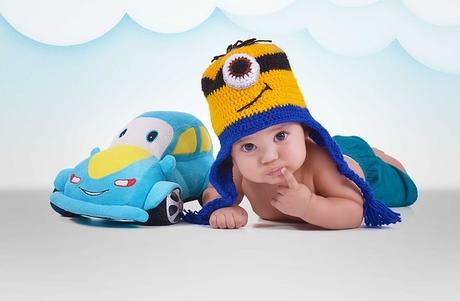
As your baby’s head and neck get stronger, she can enjoy some tummy time on the floor. By 3 months, most babies have developed enough strength to raise their head above the level of their body. At first, they can lift the head to an angle of 45 degrees; later they can lift it higher to 90 degrees. Babies support themselves on their forearms or hands when pushing up. As they get stronger, they’ll start kicking their legs too.
Tummy time is very important for babies to strengthen all the muscles required for upcoming milestones like rolling over, crawling and sitting. Ensure enough tummy time every day, and place a soft rug if the floor is cold. Place some of baby’s favorite toys around him so he’s encouraged to look up and reach out for them. You can also use a tummy time pillow to prop the baby up.
3. Sitting with Support

Most parents place their babies in a supported half-seating, half-lying position early on, using pillows or in bassinets. However, by 5-6 months, most babies can sit well with support, which is generally the age babies start eating solid food. Babies this age have also lost the ‘head lag’ when they are pulled into a sitting position with their hands.
At this age, the baby’s lower back, bottom and hips need to be supported, but he can usually balance himself, using his arms to prop himself up. This is called the tripod seating position. This helps babies develop a strong core and gives them confidence to use both hands more freely.
4. Sitting without Support
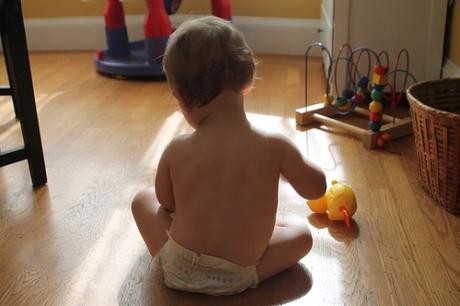
By 8 months, most babies have developed enough core strength and balance to sit without support for at least some time. They still use their arms for balance, but they have much more control now, and there’s less falling to the sides.
One common problem at this age is sitting with a ‘curved back’. This could happen due to a variety of reasons, and it’s best to correct it early. Maybe their muscles are not strong enough yet, in which case they need support for a little longer, so you can avoid a rounded back and bad posture in the future.
This is a great age for some simple exercises to improve strength and balance. Let baby sit with legs in different positions – straight out, butterfly position (knees bent with soles of feet together), crossed legs, Z legs (one leg bent and the other straight). Alternate legs with the crossed legs and Z legs positions.
5. Crawling
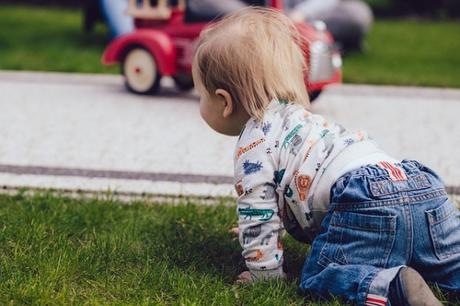
Crawling is a very complex activity and is usually the baby’s first way of moving around. Because of the various muscles and body parts involved in crawling, there are many combinations that result in different kinds of crawling. Here are the most common types of crawling seen in babies:
1. Classic Hands and Knees – This is the most common kind of crawling, where the baby supports her weight on the hands and knees before moving an opposite arm and knee forward. This motion continues with alternating arms and knees.
2. Bear Crawl – In the bear crawl, the baby walks on her hands and feet, making a bridge and looking much like a bear. It is similar to the classic crawl except that the knees are unbent in this one.
3. Belly Crawl – This usually comes as a natural transition from tummy time to many babies, as they move their body forward on their bellies, without using the hands and knees for support.
4. Bottom Crawl – This is less of a ‘crawl’, as the baby pushes herself forward on her bottom, using her arms for support.
There are other variations of crawling too, and none of these are abnormal. Encourage your baby by having things like cushions and pillows around to challenge her. Make sure the space is safe and open by carrying out adequate childproofing measures.
6. Standing
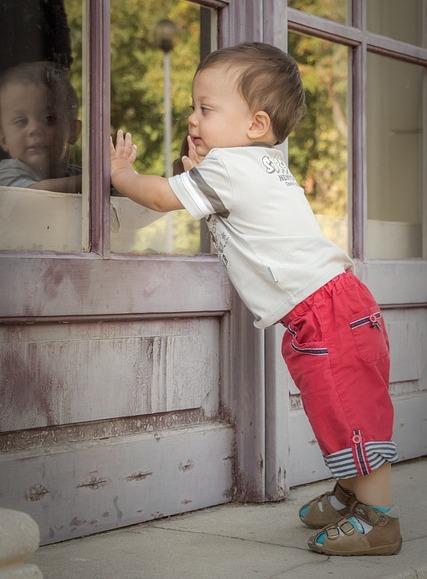
If you hold your 5 month old upright, you’ll find that they straighten their knees and try to stand and support their own weight. This shows that their body is getting ready to prepare for standing. By 7 months, most babies can pull themselves up to a standing position holding on to furniture.
At this stage, balance is a problem. Babies start by standing on their toes, gradually learning to balance on the whole foot. The feet are usually at hip width apart, the body is slightly bent forward and they can topple easily. Soon babies get stronger so that they can support themselves with one hand, while the other is free to hold a toy or do something else. Getting back down is still difficult, and they often land on their bottoms. Make sure the floor is soft to cushion their falls.
By 9 months, pulling up to a standing position becomes much easier. With time, they learn how to get down – by bending the knees and using the hands to go down in front. As your baby does this multiple times a day, she strengthens her hips, knees and ankles, which are crucial to prepare for walking. Most babies start out by being able to stand independently for about 2 seconds, which then increases as their balance improves.
7. Walking
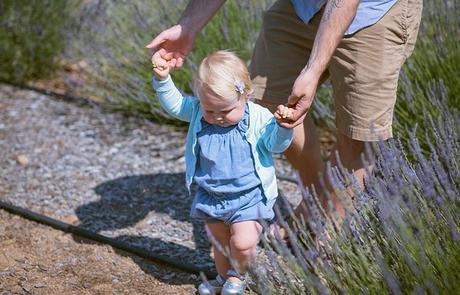
Walking is probably the milestone that is most looked forward to by new parents. However, taking that first step requires a good deal of balance, muscle work and coordination, and the preparation for this has been happening all the time baby was reaching her other milestones.
Once the baby has learnt to stand independently with good balance, she’ll start cruising, or walking holding on to furniture. This requires shifting the weight to one foot and moving the other foot in perfect sync, and takes a bit of time to perfect. It is important to watch out for posture during this stage, to identify problems if any. Here are some of the common issues seen in children starting to walk.
1. Bow Legs – This is a condition where the lower legs seem to have a curve to them. Nearly all babies have some degree of bow leggedness, due to the legs being cramped up in the womb. As the child grows and starts to walk, the legs naturally straighten out.
2. Pigeon Toes – Pigeon toes can include in-toeing or out-toeing – referring to when the feet turn inwards or outwards, respectively. This usually happens because of a rotation in the upper or lower leg bones. Again, this is something that clears out on its own, although kids with pigeon toes may trip a little more when walking.
3. Knock Knees – Babies are born with gaps in their knees to help them adjust in the small space in the womb. This gap closes as they grow, but sometimes the bones may overcorrect or get too close, leading to a condition called knock knees. This is harmless and the knees usually line up by age 6-7.
4. Tiptoe Walking – Being cramped up in the fetal position can lead to shorter Achilles tendons in babies. This means they find it difficult to land on their entire foot, with the heels down. Such babies may start out by walking on tiptoe, but they naturally learn to bear weight on their entire foot by stretching out the Achilles tendon as they get more practice.
8. W Sitting
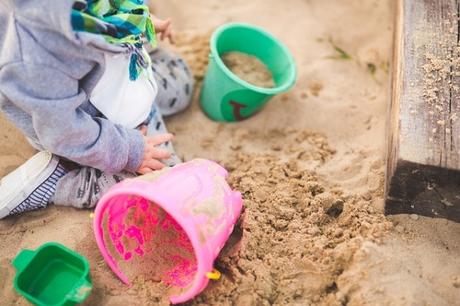
When speaking about posture, it’s a good idea to look at one particular posture that got many parents worried and was a topic of much discussion – the W sitting posture. In this posture, the child’s bottom is on the ground, while the legs are bent on either side of the body. So if you look down at a child sitting like this, it looks like a ‘W’.
A child who sits in this position does so because it’s comfortable and stable. Parents worried that sitting like this would weaken the hip and leg muscles, and makes it difficult to rotate the upper body. However, experts now say that this is just a natural position for the child who may be compensating for some rotation in the leg bones that was caused by the baby’s position in the womb. In any case, it is something that resolves itself as the child gets stronger and more stable.
Please remember that these are general guidelines and each baby develops and grows in his or her own way, in his or her own time. It’s also important to note that premature baby milestones will be different from full term babies, depending upon how premature the baby is. Don’t force the baby into any pose; when left to develop naturally, most babies get the best posture on their own. All you need to do is to provide a safe space to explore and watch out for any problems. Avoid too much use of baby gear like bouncers or jumpers and certainly say ‘No’ to baby walkers. Overuse of such equipment can delay development and the best way is to get down on the floor with baby, and let her take her own time.
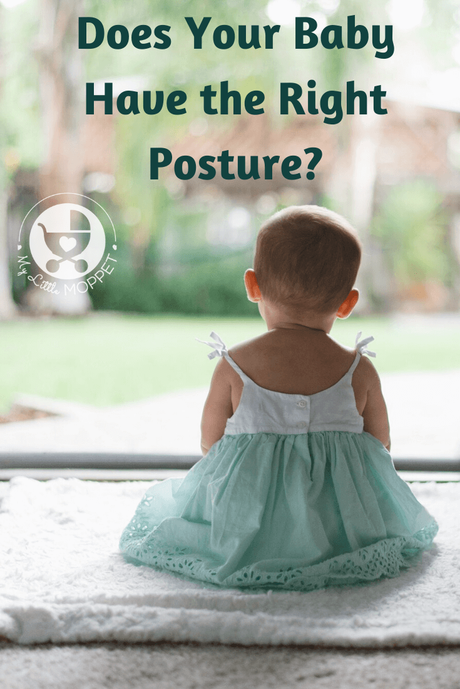
Organic · FSSAI Certified · NABL Lab certified Buy Sprouted Sathumaavu Health Mix powder for Babies / Homemade Cerelac Dry Fruits Powder for Babies/Toddlers Pancake Mixes for Toddlers TweetPinShareWhatsAppEmail
Filed Under: Baby, Baby health, Growth and Weight, Parenting Tagged With: babies, baby, Baby Development, baby health, growth, health, milestones, parenting, parenting tips, posture
